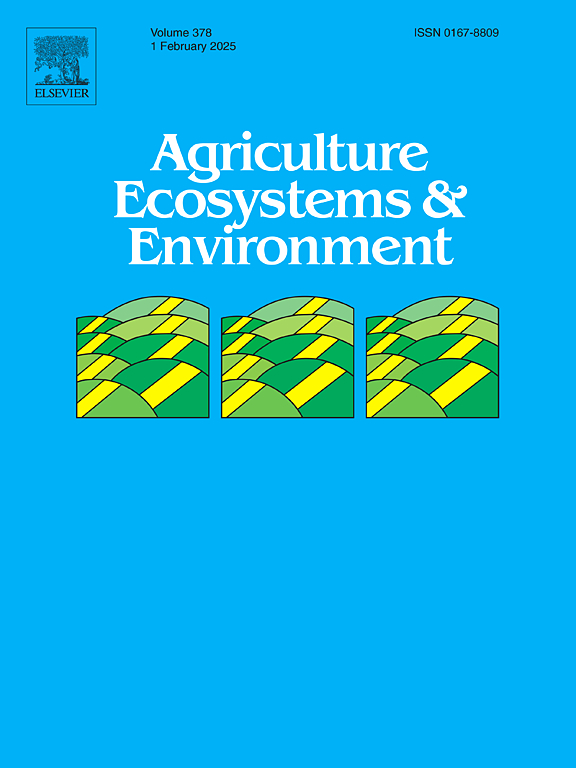微生物接种剂对加入覆盖作物后的温室气体排放影响甚微
IF 6
1区 农林科学
Q1 AGRICULTURE, MULTIDISCIPLINARY
引用次数: 0
摘要
一种净负排放技术是将二氧化碳转化并以土壤有机碳(SOC)的形式储存在农业土壤中。在农业中增加土壤有机碳储量的一种方法是在土壤上层种植和加入覆盖作物。然而,加入新鲜植物材料也会增加一氧化二氮的排放,从而降低整体温室气体减排效果。虽然去除植物材料的效果相对较好理解,但不同的掺入方法和覆盖作物接种微生物接种剂(MI)的效果仍鲜为人知。为了研究这些影响,我们进行了一项孵化研究和一项田间试验,在试验中,在种植草-三叶草覆盖作物后种植玉米。我们测量了温室气体排放量(N2O、CO2)、土壤参数(Nmin、DOC、土壤湿度和温度)、土壤有机碳(SOC)储量和玉米产量。在加入覆盖作物后的四周内,浅层旋耕产生的二氧化碳排放量比犁耕高出 30%,而去除覆盖作物生物量后,N2O 和二氧化碳排放量明显降低,与覆盖并接种 MI 的情况相同。就整个季节而言,去除地上覆盖作物生物量往往会使田间的一氧化二氮排放量减少 21%,而在田间添加多元醇后,一氧化二氮的减少趋势并不明显。不同耕作机具的 N2O 排放总量没有差异。0-20 厘米范围内的 SOC 储量在一年内没有变化。犁耕的玉米产量比旋耕高 23%。总体而言,在覆盖作物掺入过程中添加多元醇可能会改善温室气体平衡,但其他管理和气象因素对其潜在影响的叠加效应太强。因此,关于多元智能是减少农业温室气体排放的一种选择的说法仍然证据不足。本文章由计算机程序翻译,如有差异,请以英文原文为准。
Microbial inoculant has little effect on greenhouse gas emissions following cover crop incorporation
A net negative emissions technology is the transformation of CO2 and its storage in agricultural soils in form of soil organic carbon (SOC). One possibility to increase SOC stocks in agriculture is to grow and incorporate cover crops in the upper soil layer. However, incorporation of fresh plant material can also increase N2O emissions and thereby reduce the overall greenhouse gas mitigation effect. While the effect of removing plant material is relatively well understood, the effect of different incorporation methods and the inoculation of cover crops with microbial inoculant (MI) is still poorly known. To investigate these effects, we conducted an incubation study and a field trial where a grass-clover cover crop was followed by maize. We measured greenhouse gas emissions (N2O, CO2), soil parameters (Nmin, DOC, soil moisture and temperature), soil organic carbon (SOC) stocks and maize yield. In the four weeks following cover crop incorporation, shallow rotary tillage induced 30 % higher CO2 emissions than ploughing and removal of cover crop biomass resulted in significantly lower N2O and CO2 emissions as if it was mulched and inoculated with MI. Regarding the whole season, removal of aboveground cover crop biomass reduced N2O field emissions in tendency by 21 %, whereby the trend in N2O reduction by adding MI in the field was less pronounced. Total N2O emissions did not differ between tillage implements used for incorporation. SOC stocks did not change within 0–20 cm within a year. Maize yield was 23 % higher with ploughing than rotary tillage. Overall, the addition of MI during cover crop incorporation might improve the greenhouse gas balance, but potential effects are superimposed too strongly by other management and meteorological factors. Therefore, claims that MI are an option to mitigate greenhouse gas emissions from agriculture remain weakly substantiated.
求助全文
通过发布文献求助,成功后即可免费获取论文全文。
去求助
来源期刊

Agriculture, Ecosystems & Environment
环境科学-环境科学
CiteScore
11.70
自引率
9.10%
发文量
392
审稿时长
26 days
期刊介绍:
Agriculture, Ecosystems and Environment publishes scientific articles dealing with the interface between agroecosystems and the natural environment, specifically how agriculture influences the environment and how changes in that environment impact agroecosystems. Preference is given to papers from experimental and observational research at the field, system or landscape level, from studies that enhance our understanding of processes using data-based biophysical modelling, and papers that bridge scientific disciplines and integrate knowledge. All papers should be placed in an international or wide comparative context.
 求助内容:
求助内容: 应助结果提醒方式:
应助结果提醒方式:


